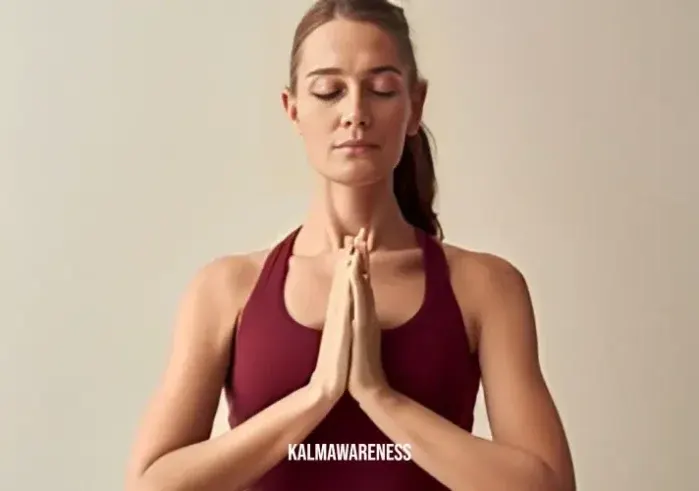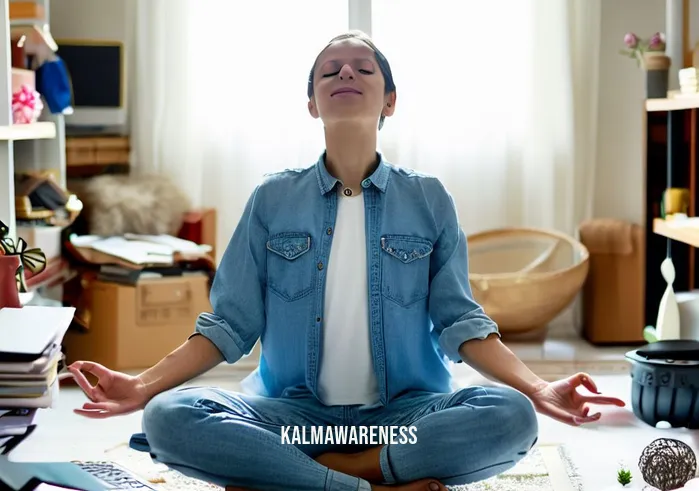Experiencing Tranquility with 4-2-6 Breathing: Master Your Breath, Master Your Life
Let’s embark on a journey of self-discovery, understanding the nuances of our breath. We start by examining the 4-2-6 breathing technique, a simple but potent method known to cultivate calmness and reduce stress. Are you ready to uncover the secrets of your breath?
Understanding the Power of Breath

Often overlooked, our breath is a tool waiting to be utilized. Breathing doesn’t just supply our body with the necessary exchange of oxygen and carbon dioxide. As highlighted in our post on Gentle Air Movements, it’s also a bridge connecting mind and body, influencing our reactions to life’s stressors, whether they’re fleeting moments of anxiety or long-term stresses.
What is 4-2-6 Breathing?
4-2-6 breathing is a breathwork technique that’s simple, yet effective, easily implemented anywhere, anytime. Let’s break it down:
- Inhale for a count of 4.
- Hold the breath for a count of 2.
- Exhale for a count of 6.
This technique cultivates a sense of calm, slowing down our breathing rate and encouraging a relaxed state of mind. This is not dissimilar to the 3 deep breaths technique, although the addition of a specific count adds a layer of focus, helping to quiet the mind further.
Why 4-2-6 Breathing?
It’s all about balance. When stressed, our breathing rate can increase, resulting in an imbalance of oxygen and carbon dioxide in our bodies. This can make us feel more anxious. The 4-2-6 breathing technique helps restore this balance by extending the exhale, which naturally encourages relaxation.
How to Practice 4-2-6 Breathing
The beauty of 4-2-6 breathing lies in its simplicity. It doesn’t require any special equipment, and you can practice it whether you’re at home, in your office, or even amidst nature. Here’s how to get started:
- Find a Comfortable Position: Whether it’s sitting straight in your meditation corner or lying down in your bed, choose a position that’s comfortable for you. If you’re sitting, remember the importance of a straight spine, as discussed in our post on how important is a straight spine in meditation.
- Close Your Eyes: This can help minimize distractions and focus more on your breath. However, if you prefer to keep your eyes open, softly gaze at a fixed point in front of you.
- Start Breathing: Begin the cycle by inhaling for a count of 4, holding your breath for 2 counts, and then exhaling for a count of 6. The key is to make sure your breathing is deep and steady, filling up and emptying your lungs completely.
- Repeat: Continue this cycle for a few minutes or until you feel your body and mind relax.
This is just the beginning of our exploration of the 4-2-6 breathing technique. I invite you to join me in the next part of this article where we’ll delve deeper into the science behind this method, its benefits, and how it can be integrated into your daily routine for stress reduction and improved wellbeing. Don’t miss out!

The Science Behind 4-2-6 Breathing: Your Ticket to a Calm Mind
As we dive deeper into the 4-2-6 breathing technique, let’s delve into the science that makes it so effective. As you will learn, it’s not just about counting breaths but the intricate connection between your breath and your nervous system.
The Physiology of Stress and Calmness
Stress induces a “fight or flight” response, where the body prepares itself to either confront or flee from potential harm. As a result, your heart rate increases, muscles tense up, and breathing becomes rapid. In the modern world, numerous triggers, like work pressure or traffic jams, can provoke this response unnecessarily, leading to chronic stress.
On the other hand, 4-2-6 breathing stimulates the “rest and digest” response, promoting relaxation. It’s linked to the parasympathetic nervous system, the part responsible for conserving energy and enhancing relaxation. But how does this technique achieve that effect?
Breathing and the Nervous System
Your breath is directly linked to your nervous system. As our Find Your Breath post details, specific patterns of breathing can either stimulate your body’s stress response or promote calm.
Longer exhales compared to inhales, like in 4-2-6 breathing, activate the vagus nerve, a critical part of your parasympathetic nervous system. Stimulation of this nerve lowers the heart rate and blood pressure, leading to a state of relaxation.
Visualizing Your Breath
As we embark on this journey of breath control, visualizing your breath can play a pivotal role. Just as we explored in our guided journey meditation, visualization can enhance the practice by offering a tangible focus for the mind.
Imagine a wave rising and falling on a serene beach. As you inhale for four counts, visualize the wave rising. Hold your breath for two counts as the wave reaches its peak. As you exhale for six counts, visualize the wave falling. This imagery can assist you in channeling the serene rhythm of 4-2-6 breathing.
This is a glimpse into the science behind the 4-2-6 breathing technique and its relationship with our nervous system. Stay tuned for the next part where we’ll delve into the benefits of this technique, providing practical insights on how it can transform your daily life and stress management. The journey continues!
Harnessing the Power of 4-2-6 Breathing: Stress Reduction and Beyond
After understanding the science behind 4-2-6 breathing, it’s time to explore its myriad benefits. From stress reduction to improved sleep, this technique has potential to bring transformative changes to your life.
Effective Stress Management
Breathing exercises, like the 4-2-6 breathing, are potent tools for stress management. As we’ve discussed in our post 3 Deep Breaths, the way we breathe can profoundly impact our emotional state. By elongating your exhales and slowing down your breathing, you signal your body to relax, thereby reducing stress.
Improved Sleep Quality
If you struggle with sleep or if you’re searching for a method to wind down before bedtime, 4-2-6 breathing may be your answer. It’s proven to facilitate sleep, as indicated in our article Fast Sleep Meditation. The calming effect of this breathing pattern prepares your body for a good night’s sleep, helping to combat insomnia.
Better Concentration and Mindfulness
4-2-6 breathing can also enhance your focus and mindfulness. The practice of maintaining the rhythm and counting your breaths helps in keeping your mind in the present, deterring it from wandering. It’s a beneficial tool to incorporate in your mindful movement meditations as well, supporting a greater sense of presence during the activity.
Physical Health
The long-term practice of 4-2-6 breathing also impacts physical health. Lowering stress levels has a positive effect on the immune system, blood pressure, and overall heart health. Furthermore, it improves digestion by stimulating the parasympathetic nervous system, as referenced in our Gentle Air Movements article.
These are just a few of the benefits of adopting the 4-2-6 breathing technique into your daily routine. Stay tuned as we move to the next chapter, where we will guide you through a step-by-step process of performing this technique. Your journey to tranquility continues!
A Step-by-Step Guide to 4-2-6 Breathing: Your Path to Tranquility
By now, you’ve delved into the science and benefits of 4-2-6 breathing. Let’s now guide you on how to perform this technique to optimize your mindfulness and well-being.
Step 1: Get Comfortable
To begin, find a quiet, comfortable place where you can relax without interruptions. It can be a cozy corner in your home or a tranquil spot in your garden. Settle into a comfortable seated or lying down position, ensuring your spine is straight.
Step 2: Breathe Naturally
Start by taking a few natural breaths. Allow yourself to relax and let go of any tension. Pay attention to the sensation of your breath coming in and going out. You can refer to our post on Finding Your Breath for more guidance on this step.
Step 3: Start 4-2-6 Breathing
Now, slowly inhale through your nose for a count of 4. Hold your breath for a count of 2. Then, exhale gently through your mouth for a count of 6. Feel the air leaving your lungs, your body relaxing with each exhale.
Step 4: Maintain the Rhythm
Continue this pattern, maintaining the 4-2-6 rhythm. It might be a bit challenging at first, but with practice, it will come naturally. You can experiment with different counts if this rhythm doesn’t feel comfortable for you, as mentioned in our article 55 Breaths Per Minute.
Step 5: Return to Normal Breathing
After a few minutes, or when you feel ready, slowly return to normal breathing. Notice the calmness and relaxation in your body and mind. Congratulate yourself for taking this time to practice mindfulness and self-care.

Remember, consistency is key in seeing the benefits of 4-2-6 breathing. Aim to practice daily, even if just for a few minutes. Incorporate it into your morning meditation routine or use it to wind down before bed.
In the next and final chapter of this article, we’ll discuss ways you can integrate this potent technique into your everyday life. Let’s continue the journey!
Incorporating 4-2-6 Breathing into Everyday Life: A Breath of Fresh Air
After mastering the technique, the next step is to weave 4-2-6 breathing into the fabric of your daily life. This powerful technique can be your constant companion, helping you navigate stress, focus your mind, and maintain a balanced emotional state.
Use It for Stress Reduction
4-2-6 breathing can be an effective tool for reducing stress levels. Whenever you feel anxiety creeping in, take a moment to engage in this breathing practice. It acts as a natural stress reducer, as discussed in our guide Breathing Techniques and Stress Reduction.
Integrate It into Your Meditation Practice
Enhance your meditation sessions by starting them with 4-2-6 breathing. It helps to quiet the mind and prepare you for deeper meditation. You may choose to follow along with one of our Guided Meditations for Deep Sleep to further integrate this practice into your daily routine.
Use It to Improve Sleep Quality
The calming effects of 4-2-6 breathing can also help you prepare for sleep. Try incorporating it into your bedtime routine, perhaps along with a guided sleep meditation with music, to help you drift off into a peaceful slumber.

Share It with Your Loved Ones
Practicing 4-2-6 breathing together with your loved ones can be a rewarding experience. You may consider introducing this technique in a family meditation session, as suggested in our post on Family Circle Meditate.
By integrating 4-2-6 breathing into your life, you’re taking a significant step towards better mental and emotional health. The beauty of this technique lies in its simplicity and versatility, making it an easily accessible tool for everyone.
Thank you for joining us on this journey towards mindful breathing and improved well-being. Keep exploring our other posts to continue enriching your path towards mindfulness and serenity. Breathe on!




